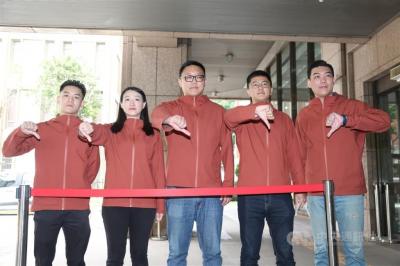China’s frequent missions near Taiwan during the past few months are part of Chinese officials’ overall strategy of influencing the nation’s public opinion, according to analysts in Taiwan.
The People’s Liberation Army (PLA) forces passed near Taiwan on deep-ocean training exercises 25 times from August to December last year, the Ministry of National Defense said in its year-end report last month.
By contrast, the PLA annually conducted four such training missions during the preceding few years. When Taiwan, Japan and South Korea began reporting on the missions, Chinese media also began to cover them, making comments about China’s right to carry them out.
Following exercises on Nov. 22 and 23, the PLA’s official account on messaging service Weibo showed Chinese Xian H-6K bombers flying within view of a mountain range that China’s Sina military news service claimed to be Taiwan’s Yushan (玉山).
After the PLA Air Force flew over Japan’s Miyako Strait and over the Bashi Channel on Dec. 12, more photos appeared on the PLA’s Weibo channel alongside a report saying that similar routine training exercises are to be the norm in the future. The report also differed from past PLA reports in that it specifically mentioned “encircling the island.”
The report asked readers: “Guess what island we encircled?” The accompanying pictures showed bombers joined by a formation of Shenyang J-11 fighters.
The PLA announced on Dec. 18 that bombers, fighters and reconnaissance aircraft would be passing over the Tsushima Strait toward international waters off the coast of eastern Japan to test their combat capability over long distances.
Lin Ying-yu (林穎佑), assistant professor at National Chung Cheng University’s Institute of Strategic and International Affairs, on Wednesday said the PLA is attempting to cause social disturbances in Taiwan by reporting on its activities.
Reports that mix true and falsified information will appear with increasing frequency, Lin said.
Communists have been using propaganda since the Chinese Civil War, Lin said, adding that the advent of the digital age has resulted in a “digital cold war.”
They are especially adept at using propaganda since they maintain full control over the media and over Internet use in China, he said.
China’s propaganda campaign has an internal front, which has been focusing on the corruption crackdown to show the Chinese public how much power the PLA holds, and an external front, which can be seen in the recent Weibo posts about military exercises and is aimed at Taiwan, Lin said.
With the frequent and close interactions today between people on both sides of the Strait, it is particularly easy for China’s “Internet army” (五毛黨) to spread false information on social media platforms and cause panic among Taiwanese netizens, Lin said.
The Chinese Communist Party first made mention of its intention to focus more on ideological warfare in 2014, at the time saying: “Future battles will not be won in the air; rather, military strategists will have to vie for control over the battlefields of public discourse and control of unseen public opinion.”
Whether the PLA’s actions represent routine exercises or preparation for war, the ministry is always ready for action, Ministry of National Defense spokesman Major General Chen Chung-chi (陳中吉) said.
“We neither fear war, nor ask for war,” Chen said. “We have the confidence and the ability to protect the safety of the nation’s territory.”
“There is no need to feel restless over a few pictures,” he added.

Taiwan is stepping up plans to create self-sufficient supply chains for combat drones and increase foreign orders from the US to counter China’s numerical superiority, a defense official said on Saturday. Commenting on condition of anonymity, the official said the nation’s armed forces are in agreement with US Admiral Samuel Paparo’s assessment that Taiwan’s military must be prepared to turn the nation’s waters into a “hellscape” for the Chinese People’s Liberation Army (PLA). Paparo, the commander of the US Indo-Pacific Command, reiterated the concept during a Congressional hearing in Washington on Wednesday. He first coined the term in a security conference last

Prosecutors today declined to say who was questioned regarding alleged forgery on petitions to recall Democratic Progressive Party (DPP) legislators, after Chinese-language media earlier reported that members of the Chinese Nationalist Party (KMT) Youth League were brought in for questioning. The Ministry of Justice Investigation Bureau confirmed that two people had been questioned, but did not disclose any further information about the ongoing investigation. KMT Youth League members Lee Hsiao-liang (李孝亮) and Liu Szu-yin (劉思吟) — who are leading the effort to recall DPP caucus chief executive Rosalia Wu (吳思瑤) and Legislator Wu Pei-yi (吳沛憶) — both posted on Facebook saying: “I

The Ministry of Economic Affairs has fined Taobao NT$1.2 million (US$36,912) for advertisements that exceed its approved business scope, requiring the Chinese e-commerce platform to make corrections in the first half of this year or its license may be revoked. Lawmakers have called for stricter enforcement of Chinese e-commerce platforms and measures to prevent China from laundering its goods through Taiwan in response to US President Donald Trump’s heavy tariffs on China. The Legislative Yuan’s Finance Committee met today to discuss policies to prevent China from dumping goods in Taiwan, inviting government agencies to report. Democratic Progressive Party Legislator Kuo Kuo-wen (郭國文) said

The Ministry of Economic Affairs has fined Taobao NT$1.2 million (US$36,900) for advertisements that exceeded its approved business scope and ordered the Chinese e-commerce platform to make corrections in the first half of this year or its license would be revoked. Lawmakers have called for stricter supervision of Chinese e-commerce platforms and more stringent measures to prevent China from laundering its goods through Taiwan as US President Donald Trump’s administration cracks down on origin laundering. The legislature’s Finance Committee yesterday met to discuss policies to prevent China from dumping goods in Taiwan, inviting government agencies to report on the matter. Democratic Progressive Party